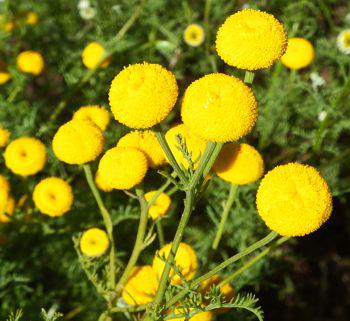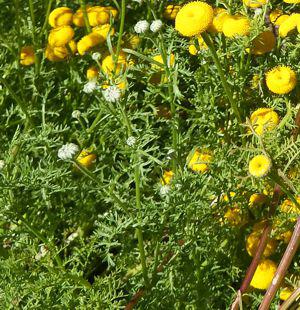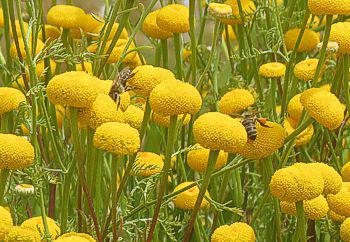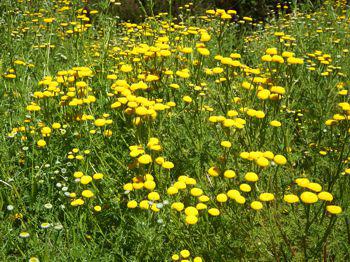Oncosiphon grandiflorum
Oncosiphon grandiflorum (Thunb.) Källersjö
Family: Asteraceae
Common names: matricaria (Engl.); groot stinkkruid, knoppies-stinkkruid, stinkkruid (Afr.)
Introduction
This tall, button-flowered annual is ideal for larger gardens and can be grown as a spring and summer annual.

Description
Description
A robust, erect and loosely branched, slightly hairy, annual herb, growing 100–450 mm high. The bipinnatisect leaves are finely divided and up to 60 mm long. The leaf lobes are narrow.

The solitary flower-heads with yellow disc-florets are 7–10 mm in diameter. The woolly involucral bracts are in 2 rows with membranous margins.
Flowering is from September–November.
Conservation Status
Status
According to the website http://redlist.sanbi.org accessed on 14 September 2015, the conservation status of this plant is LC (Least Concern).
Distribution and habitat
Distribution description
Oncosiphon grandiflorum is found from southern Namibia, throughout Namaqualand in the Northern Cape towards Melkbosstrand in the Western Cape. In these areas it is found on sandy and stony flats, as well as lower slopes and disturbed or ploughed areas.
Derivation of name and historical aspects
History
The genus name, Oncosiphon, is derived from the Greek word oncos, meaning ‘thick, swollen’, and siphon, meaning ‘tube’, and refers to the swollen corolla tube characteristic for the genus.The specific epithet, grandiflorum, means ‘large-flowered’, referring to the flowers of the species.
The genus Oncosiphon is endemic to southern Africa and consists of 7 species which are mainly found in Namibia and the Western and Northern Cape.
Ecology
Ecology
During the flowering-period, bees and beetles can constantly be observed visiting this aromatic plant.

The stinkkruid is an annual which means it complete its life-cycle in a single season. It is, therefore, very opportunistic and the availability of water enables seed-germination outside the normal season. This opportunism allows this species to be utilized as both a spring and summer annual.
Uses
Use
No uses or cultural aspects are recorded.
Growing Oncosiphon grandiflorum
Grow

Sow seed from February–March (spring annuals) or September–October (summer annuals) in well-drained soil. It will germinate less than 10 days. Feed young seedlings with diluted, liquid fertilizer. Plant it in rockeries, along edges of flower beds in larger gardens or interplant with other annuals. It performs particularly well with Senecio elegans, another late spring bloomer and of similar height.
Other companion plants include: Dimorphotheca sinuata and D. pluvialis, Dorotheanthus bellidiformis, Nemesia strumosa, Oncosiphon suffruticosum, Arctotis hirsuta and A. stoechadifolia, Pelargonium capitatum and P. cucculatum and Lampranthus aureus and L. amoenus.
It can often be prone to a fungal attack in the garden. This disease can be controlled by using combinations of systemic and contact fungicides.
References
- Goldblatt, P & Manning, J. 1996. West Coast. South African Wild Flower Guide 7. Botanical Society of South Africa, Cape Town.
- Joffe, P.1993. The gardener’s guide to South African plants. Tafelberg Publishers, Cape Town.
- Leistner, O.A. (ed.). 2000. Seed plants of southern Africa: families and genera. Strelitzia 10. National Botanical Institute, Pretoria.
- Le Roux, A. & Schelpe, T. 1988. Namaqualand. South African Wild Flower Guide 1. Botanical Society of South Africa, Cape Town.
- Magee, A. 2011. Oncosiphon suffruticosum. http://www.plantzafrica.com/plantnop/oncosiphsuff.htm
- Manning, J.C. & Goldblatt, P. 2013. Plants of the Greater Cape Floristic Region. 1: The Core Cape Flora. Strelitzia 29. South African National Biodiversity Institue, Pretoria.
- Stearn, W. 2002. Stearn's dictionary of plant names for gardeners. Timber Press, Portland, Oregon.
Credits
Roger Oliver
Kirstenbosch National Botanical Garden
October 2015
Plant Attributes:
Plant Type: Bi/Annual
SA Distribution: Northern Cape, Western Cape
Soil type: Sandy
Flowering season: Spring, Early Summer, Late Summer
PH: Neutral
Flower colour: Yellow
Aspect: Full Sun
Gardening skill: Easy
Special Features:
Horticultural zones











Rate this article
Article well written and informative
Rate this plant
Is this an interesting plant?
Login to add your Comment
Back to topNot registered yet? Click here to register.